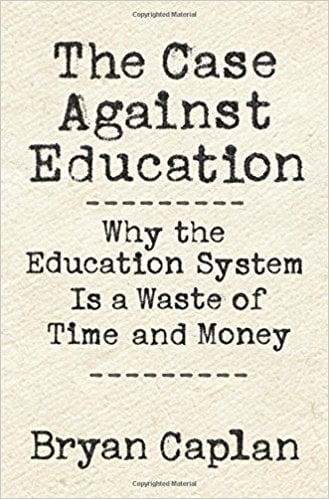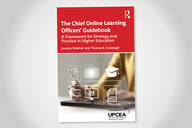You have /5 articles left.
Sign up for a free account or log in.
 The Case Against Education: Why the Education System Is a Waste of Time and Money by Bryan Caplan
The Case Against Education: Why the Education System Is a Waste of Time and Money by Bryan Caplan
Published in January of 2018.
The Case Against Education provides the best possible evidence for the value of higher education.
Not because of what Bryan Caplan, an economics professor at George Mason University, argues in the book. As you can tell by the book’s title, he is not a champion of the university.
Rather, The Case Against Education affirms the value of higher education because it is this system from which the book emerged. Where else are thinkers free to publish passionate arguments against their employers? Caplan is the poster child as to why academic freedom is so vital.
Even though I will try to show why Caplan is wrong in most of his arguments and all of his conclusions, I am thrilled that he was able to write such a provocative and well-researched book. Academia is never better than when we embrace our smartest critics.
So where does Caplan get it wrong? Well, just about everywhere.
The easiest place to start is how Caplan gets online education wrong. Caplan makes the (unfortunately all too common) mistake of conflating online education with open online education. In Caplan’s defense, academics on the left seem as likely to make this mistake as those on the right.
A traditional online course, where classes are small and built on faculty/student interaction, is very different than an open online course. The former is expensive and does not scale, the latter is cheap (on a marginal cost basis) and does scale.
Caplan may have some compelling arguments to make about how open online learning and alternative credentials may change higher education. But in failing to distinguish between the impacts that traditional and open online education are having, his arguments come across as ill-informed.
A second curious theme of The Case Against Education is Caplan’s case for signaling theory. This theory says that education is valuable not for the skills that it imparts, but for the signals that it sends. Employers favor Ivy League graduates not for what they learned as students, but because they were accepted into an Ivy League school.
By Caplan’s estimate, about 80 percent of the value of education goes to signaling, 20 percent goes to skills. What academics call human capital. Caplan then claims that because education is mostly signaling, that investing in education is a bad deal for society - and maybe a lousy deal for individuals.
What I find strange about Caplan’s argument for signaling theory is not that it is wrong. Almost every sociologist would agree. All of social life is signaling. The presentation of self in everyday life a foundational idea of sociology.
I’m not entirely sure, but I’d bet that biologists would say that signaling is a central tenet of evolution. Signaling dominance by physical characteristics or displays is much less genetically expensive than constant fighting.
Caplan seems to be making his signaling argument to a core group of labor economists with whom he has a bone to pick. These pure human capital labor economists may be real, or they may be mythical, but they certainly don’t have much influence among those working to improve education.
The validity of signaling theory does not lead to the conclusion that dollars spent on education are a poor investment. There are good educational investments and bad educational investments. There are things that we should invest our scarce dollars on, and things where we should not spend a dime. The challenge is telling those two apart.
There is much more to say as to why the truth of signaling theory is not evidence for the wisdom of educational disinvestment. After all, marriage markets are driven mostly by signaling, and that does not mean that we should abolish the institution of marriage. Yes, credential inflation is real. Yes, there are bad examples of educational investments that signaling obscures. If nothing else, The Case Against Education should motivate someone to write a pro-signaling theory and pro-education book.
Another troubling flaw in Caplan’s reasoning is his insistence that the U.S. is lavishing public dollars on education. Dollars that, in his estimation, are mostly wasted. Caplan would have had a stronger case if he separated his claims about educational funding from his analysis of return on investment.
The reality of taxpayer-provided public education funding is that the vast majority of all dollars are spent on K-12, and the vast majority of K-12 funding comes from local property taxes. States spend a relative (and declining) pittance on postsecondary education.
If Caplan is so against public education funding, then he should move to a place with low property taxes. I’m sure that Louisiana, Alabama, Arkansas, or Mississippi would welcome Caplan and his four kids.
The US is engaged in a natural experiment to test Caplan’s hypothesis on the folly of educational spending. Anyone who thinks that taxpayer dollars should not go for education should move to a state where taxpayers are not asked to contribute much to education.
Even libertarians like Caplan should know that the federal government is basically, as Peter Fisher an undersecretary of the Treasury once said, “an insurance company with an army.”
Federal tax dollars mostly go to fund intergenerational payments to older Americans and the military. Of the $4.4 trillion federal budget, $2.7 trillion is mandatory spending such as Social Security (about $1 trillion), Medicare ($625 billion), and Medicaid ($425 billion), and interest on the U.S. debt ($363 billion). The $1.2 trillion that is left for discretionary spending mostly goes to the military ($610 billion). Education gets a paltry $100 billion, or less than 3 percent of all federal spending.
The $1 trillion that Caplan cites for educational spending mostly comes from the almost $700 billion spent on K-12, which again mostly comes from local property taxes and other highly variable state sources of funding.
I do not doubt that Caplan and his defenders of educational disinvestment will have many replies to these objections. Indeed, we need much more space and time to entirely make our arguments and counterarguments.
Where The Case Against Education goes entirely off the rails is in Caplan’s analysis of student learning. I’ll restrict my comments here to higher education, as all I know about K-12 is what I experienced and what I saw kids go through.
When it comes to student learning in higher education, Caplan argues that the poor experience that so many college students endure in the classroom is evidence for the wastefulness of postsecondary spending.
Here Caplan has things exactly backward.
Bad educational experiences are the product of too little investment, not too much.
If Caplan is driving across a bridge that is poorly designed for optimal traffic, is riddled with potholes, and is potentially unsafe for drivers then I doubt his argument would be to knock down the bridge. Or to abolish all bridge building. Instead, Caplan would say that we need to build better bridges. Building better bridges may be expensive, but the alternatives (unsafe or no bridges) are far worse.
Education, even under signaling theory, is a bridge. A bridge to a better life. A fact that Caplan fully acknowledges.
What Caplan misses is that many schools, including my own, are working hard to improve the learning experience of our students. We are investing lots of resources into building better bridges.
Economists need to hang out more in Centers for Teaching and Learning. My own center has the “Advancement of Learning” in our name. Learning professionals agree that an education that does not engage a wide range of students is sub-optimal. Many colleges and universities are putting significant dollars into improving student learning.
These investments include providing faculty with training and resources in course design and learning theory. Investments can include bringing non-faculty educators such as instructional designers to partner with professors. We are also investing in classrooms and other spaces that promote active learning.
The challenge is that improving the learning experience for a wide range of students is difficult. It requires significant resources. It turns out that learning is really hard.
For many years colleges could get away with an inexpensive model of putting a professor (and maybe some TA’s) in a big lecture hall. This instructor-centric model of education has the advantage of being cheap. College teaching becomes even cheaper if the professor is an adjunct.
Today, the best schools are making investments in educational inputs. These investments start with investing in professors. And then surrounding those professors with collaborators, resources, and infrastructure.
This learner-centric educational model has the advantage of engaging a much wider range of students. The best schools no longer accept that only a few students can follow their chosen majors. If students drop out of courses, including STEM courses, the problem is as much as them. We need to do better.
What Caplan really should worry about is educational inequality. It does not seem like a positive societal result if only the minority of wealthy schools can make the investments necessary to create environments that are conducive to learning.
Further cuts in public funding for higher education, as Caplan advocates for, will only increase the divide between educational haves and have-nots.
Our society does not spend too much on education; we spend too little.
Our society does not focus too much on education; we focus too little.
We don’t spend too much time in quality postsecondary undergraduate and graduate programs; we spend too little.
What The Case Against Education provides us is an opportunity to have this discussion. Caplan was willing to put the hard work in to make a theory and data supported arguments against education.
Those of us who believe in education should do no less.
What are you reading?




